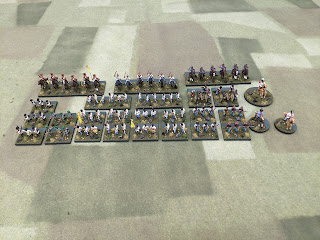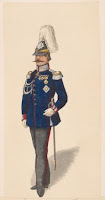The view from behind the Prussian line early in the game.
For anyone following along, this post has an "important" update on the Chocolate Box Wars (CBW) rules system. Last week, I ran a game (using the introductory scenario) to introduce friend and fellow club member Greg to the system. Intro game aside, I also used this game to proof a slightly more permissive "move and fire" rule for field and light artillery. More on that after the game report. Speaking of which, I was busy facilitating the game, so the game report will be rather abbreviated. Scroll through to find the new rules note at the end of the post. As usual, you may clix pix for BIG PIX in this post. I took the game on the road to Greg's house and ran it in his war room. Sticking with the introductory scenario, I brought the Danes and the Prussians. Mike (left) took the Danes and Greg (right) took the Prussians. The initial setups, seen above, were very linear. I think this had something to do with the set on areas being 8 inches deep as opposed to 12 (Greg's table is 4 feet by 6, and so the set-on areas are in compliance with the standard rules, which assume a 4'x6' table). My table is 5' x 6' and so the set on areas are 12" deep as opposed to 8"--interesting to see how that 4" difference influenced the set ups. Both sides advance: maneuver was basically straight ahead, with both sides advancing online and converging on each other in the center. I think this was, in part, due to the nature of the game. Greg was more focused on the system than any "fancy footwork" so to speak, and Mike was happy to oblige by meeting him head on. There was a cavalry on cavalry engagement on the Prussian left/Danish right that was of a different flavor than the rest of the table. The Prussian dragoons (left) came up and sent the Danish Guard Hussar light cavalry squadron packing (Mike was obliged to "retire and reform" it to save it). Then the Danish dragoons (right) came up and started to trade blows. Both sides were very streaky here, missing more often than hitting, and so it was dragoon on dragoon action here until the end of the game. Speaking of which, we called it after about 3 hours; decision to the Danes (Mike). Things were going downhill for Greg (although still in the balance), but by that time we had achieved our ends: plenty of shooting and moving and Greg was introduced to the system--and looking forward to playing the next game with a more complete understanding of the rules from the start.
THE RULES MODIFICATION
Based on feedback and observations from games thus far, we thought that artillery move and fire was a bit too restrictive (although not "broken" by any means, ie still within the bounds of playability given its more generous field of fire). So, in this game, I tried out a slightly more flexible version of move and fire for field and light artillery (note: there was no light artillery in the game, but the changes are to both types).
Above, details of the player reference showing the changed "Move and Fire" for artillery. In the original version, only horse artillery has a "move and fire" capability (above left). In the modified version, the field and light artillery also have a "move and fire" capability (above right). Specifically, the field artillery now may pivot (ie, change face) as a "move and fire" (before that, it would have been a "move": no fire). And the light foot artillery now has a 2" "Move and Fire"--basically a modest prolong, but one that includes a facing change (as per normal movement rules). As has been mentioned, the artillery does have a more generous field of fire than infantry, and so can cover a good sector of the battle and not need to change facing (normally) just to engage units. However, this version allows more discrete use of artillery by facilitating the ability of a battery to change its primary line of fire (by changing facing) in order to target a specific unit, something that would have taken two activations in the prior version (one to move and the next to fire). This more permissive version does come at the cost of fire effectiveness (moving fire is a -1, appropriate in this case since the artillery is technically shifting fire and not spending the entire step engaging the target). This was in play during this playtest and it worked well. Players sometimes used artillery to fire on units according to the normal fire priority, but there were times when they felt they needed to intervene to shift fire to a specific target other than the one in the default priority of fire. It also sped up game play since players were not spending two APs and going through two different activations to accomplish this exercise. And (finally), this added capability did add more depth to player decisions and made artillery more active than it had been in prior games, both seen as a positive steps. We'll probably play it this way in the future.
Thumbnail of the front page of new player reference
I have produced a new player reference, numbered v24a, reflecting the new rules. To make it easier to discriminate between the two, the header on the new version has a black header with white letters on a black background (the original has black letters on white). As I said, this is not a mandatory change: the original version works perfectly well--players now have options. I've added the new version to the CBW resource page as well.




























